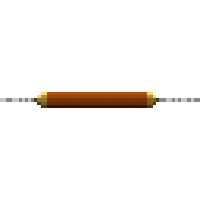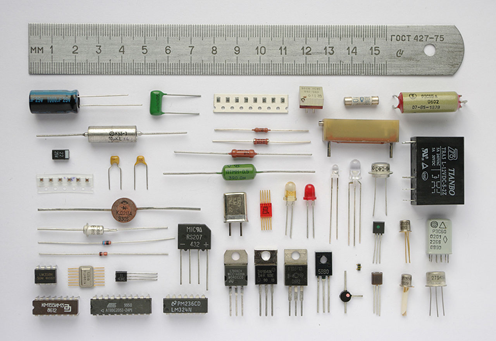
In a circuit a faulty capacitor causes a malfunction and must be changed with another one of the same capacity.
A capacitor accumulates electrical charge inside, which can be released into a circuit. It’s formed by two faces of a conductive material, divided by an insulating material. When a voltage generator is connected, the electrical charges situated in the insulator moves towards to the conductive faces, which charge themselves with negative and positive charges. This property of a capacitor is called capacitance, and the unit to measure is Farad.
In its simplest form (flat) a capacitor consists of two flat surfaces (armatures) of conductive material between which an insulating medium (dielectric) is placed. If a capacitor is connected to a voltage generator, the electrical charges in the dielectric separate and an electrical field is created within it. The two armatures are charged, one positively (the one connected to the highest potential) and the other negatively, with the same amount of charge. A capacitor therefore has the characteristic of storing electrical energy inside it by means of an electrostatic field, i.e. a field generated by a stationary charge distribution. The physical quantity that measures the ability of a capacitor to store charge is called capacity, and is given by the ratio between the accumulated charge and the voltage used to store it; the unit of measurement of the capacity is Farad (F) and generally the commonly used capacitors have capacity in the order of millionths of Farad, microFarad (uF).

Fig.1 A capacitor. The "head" shows the capacitor’s main features: in this case the capacitor has a capacitance of 1000 micro Farad and supports a voltage of 25 Volts with a maximum temperature of 105°. (Credits: Wikimedia Commons)
We can understand how a capacitor operates by building a very simple electrical circuit. The capacitor can be charged by attaching it for a few seconds to a battery. If we disconnect it and reconnect it (with a small resistor in the middle) to an LED (Light Emitting Diode) – another electrical component which emits light when it is crossed by a current – we observe that the LED will light up for a few moments as if it were connected to a battery. However, we observe that it will start to fade until it goes out as the capacitor discharges the charge it had previously accumulated. The resistor between the LED and the capacitor is placed there to make the current flow more slowly, because otherwise the capacitor would discharge very quickly, causing a spark in the LED and the risk of it burning. Of course capacitors are an integral part of even more complex circuits than the one described, such as for example a circuit used to operate a particle accelerator (See accelerator) Also within these circuits it is possible that a capacitor breaks down, for example due to a current overload or simply due to age-related wear. In such cases, the operator should pay attention to replace it with another capacitor of equivalent capacity.
Other basic components of an electric circuit are (Fig. 2): resistors – materials that cause a potential drop when crossed by a current; inductors – that generate a magnetic field when the electric current passes; and diodes – that allow the current to flow only in one direction.

Fig.2 Different electrical components. On the top left a capacitor; in the middle, arranged horizontally, a few resistors; on the bottom left, always arranged horizontally, a few inductors (characterized by different colours); in the middle, with yellow and red "heads", a few light emitting diodes. (Credits: Wikimedia Commons)

Discover the experiments and help the alien to get back home!
Play now